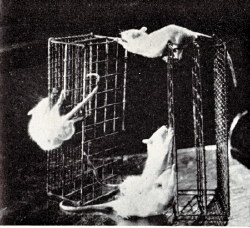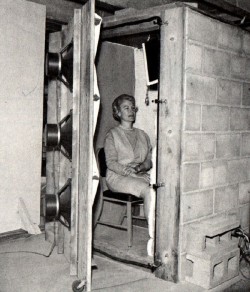Experiments
Guess the Scientist, #2
What scientist wrote the following passage? The answer is in extended (and on the comments page).A small experimental room was fitted with a bed and other items conducive to a normal sexual response. The bed was placed directly against a wall through which an opening was made. Both sides of the opening were covered with a thick sheet of foam rubber. Slits were made in the foam rubber so that the leads to the instruments could be passed to the recording room while still maintaining the privacy of the experimental room. All of the subjects were married and were between the ages of 22 and 30.
To record the heart rate four electrocardiographic leads, fashioned from wire mesh attached to an elastic bandage, were fastened to the upper thighs and the upper arms. With this technique the ECG was readable even during the periods of greatest muscular activity. During foreplay, records were taken each minute on two Sanborn direct writing electrocardiographs. During coitus continuous recordings were made, and after withdrawal records were again made a 1-minute intervals. Three tests were performed on each of three couples.
More in extended >>
Posted By: Alex - Mon Oct 20, 2008 -
Comments (9)
Category: Quizzes, Guess the Scientist, Science, Experiments
Anger and Landscape Art
 Do you feel angry and frustrated sitting in your windowless cubicle grinding away at a dead-end job? Recent research (published in the journal Environment and Behavior) indicates there may be an easy way to brighten your mood, at least if you're a man. Hang a few art posters.
Do you feel angry and frustrated sitting in your windowless cubicle grinding away at a dead-end job? Recent research (published in the journal Environment and Behavior) indicates there may be an easy way to brighten your mood, at least if you're a man. Hang a few art posters.Researchers at Texas A&M University conducted an experiment in a simulated office. Participants were told that the researchers were investigating performance on a variety of computer tasks. In reality, the computer tasks were designed to "provoke stress and anger." The question was whether the artwork hanging on the wall (abstract art, nature posters, abstract and nature posters, or no art) would modify people's moods. The conclusion:
It's not clear why men are calmed by wall art, but not women. Maybe men are just simpler creatures.
Posted By: Alex - Mon Sep 29, 2008 -
Comments (5)
Category: Art, Science, Experiments
Donation Meters

The donation meter!
The picture here portrays one in Denver, which I found on the Flickr page of msitarzewski.
Read all about Atlanta's recent experiment with donation meters here.
Posted By: Paul - Mon Sep 29, 2008 -
Comments (10)
Category: Bums, Hobos, Tramps, Beggars, Panhandlers and Other Streetpeople, Entertainment, Government, Money, Charity, Signage, Stupidity, Experiments
The Mighty Powers of Hagfish Slime
My high-school pal Sherry Mowbray, who grew up to be a top-flight biologist, points me with glee to this video illustrating how powerful is the slime secreted by the awesome hagfish.
Posted By: Paul - Wed Sep 10, 2008 -
Comments (11)
Category: Animals, Science, Experiments, Body Fluids
One Touch of Homer Makes the Whole World Kin

After briefly distracting the patients, the researchers then asked them to think about the clips for a minute and to report “what comes to mind.” The patients remembered almost all of the clips. And when they recalled a specific one — say, a clip of Homer Simpson — the same cells that had been active during the Homer clip reignited. In fact, the cells became active a second or two before people were conscious of the memory, which signaled to researchers the memory to come.
Why is Homer Simpson singled out as the test case? Obviously because the human brain has specific neurons that emulate or actually induce and compel Homer-Simpson-style behavior.
And there in a nutshell you have the whole basis for ninety-nine percent of the contents of WEIRD UNIVERSE.
Posted By: Paul - Fri Sep 05, 2008 -
Comments (13)
Category: Celebrities, Science, Experiments, Psychology, Stupidity, Television, Husbands, Cartoons
Help Zimbardo Study Helping
Dr. Phil Zimbardo, famous for conducting the Stanford Prison Experiment which revealed how quickly average college students will embrace the roles of sadistic prison guards and passive prisoners, and most recently author of The Lucifer Effect, is now turning his attention to helping behavior. From the hero workshop blog (via boing boing):The first step is to conduct a survey with as many participants as possible. That’s where you come in. The survey takes about 30 minutes and can be found at www.socialpsychresearch.org.
I took one look at the length of time and thought, "30 minutes! I don't want to take a survey for that long!" I'm basically unhelpul and selfish. But this made me realize that the only people taking the survey will be those that are more helpful than most. It'll be a biased sample.
Zimbardo and his co-researchers are very smart people, so I'm sure they realize this. I'm guessing that the real purpose of the survey may be to find out how many people actually take it, versus how many visit the link. That could provide a quick snapshot of how many helpful people there are on the internet. (Thanks to Joe Littrell!)
Posted By: Alex - Wed Aug 27, 2008 -
Comments (1)
Category: Science, Experiments, Psychology
Sonic Boom Simulation Chamber
During the 1960s NASA sponsored research into the effect of sonic booms on human subjects. This was in response to growing concern about "the nature of the boom phenomena" as supersonic aircraft were flying with increasing frequency. Shown in the picture is one subject (unidentified) about to be locked inside the "Sonic Boom Simulation Chamber."I like the juxtaposition of the prim-and-proper woman and the massive audio system. Unfortunately there aren't any pictures of what she looked like after being repeatedly blasted with simulated sonic booms.
The image comes from NASA Contractor Report CR-1192, "Relative Annoyance and Loudness Judgments of Various Simulated Sonic Boom Waveforms."
Posted By: Alex - Wed Aug 20, 2008 -
Comments (2)
Category: Science, Experiments, Technology
Catatonic Rats
Old science books and articles are a great source of weird images. For instance, I found the two pictures below in Of Mice, Men and Molecules by John Heller (published in 1960). The images are titled "Catatonic rats" and have this explanatory caption:Unfortunately, Heller doesn't reveal what the chemical is that caused the rats to freeze in these positions. My guess is that it's LSD.
 |  |
Posted By: Alex - Mon Aug 18, 2008 -
Comments (3)
Category: Animals, Drugs, Science, Experiments
The Smoke-Filled Room
If you were sitting in a waiting room and smoke began to billow out of a vent in the wall, you'd probably do something about it. At least, you'd report the problem to someone. Or maybe not.In a famous experiment conducted by John Darley and Bibb Latané during the 1960s, Columbia University students were invited to share their views about problems of urban life. Those who expressed an interest in participating were asked to first report to a waiting room in one of the university buildings where they would find some forms to fill out before being interviewed. They had no idea that the urban-life study was just a cover story. The real experiment occurred in the waiting room.
As they filled out the forms, smoke began to enter the room through a small vent in the wall. By the end of four minutes, there was enough smoke to obscure vision and interfere with breathing. Darley and Latané examined how the students reacted to this smoke in two different conditions.
In the first condition, the students were alone. When this was the case, they invariably investigated the smoke more closely and then went out into the hallway to tell someone about it.
But in the second condition, the students were not alone. There were two or three other people in the room, who were secret confederates of the researchers. They had been instructed to not react to the smoke. They would look up at it, stare briefly, shrug their shoulders, and continue working on the forms. If asked about it, they would simply say, "I dunno."
In this setting, according to Darley and Latané, "only one of the ten subjects... reported the smoke. the other nine subjects stayed in the waiting room for the full six minutes while it continued to fill up with smoke, doggedly working on their questionnaires and waving the fumes away from their faces. They coughed, rubbed their eyes, and opened the window -- but they did not report the smoke."
That's the power of group pressure.
If you ever get the chance, check out Darley and Latané's book The Unresponsive Bystander: Why Doesn't He Help? It's not easy to find because it's out of print, but it's full of strange experiments like the smoke-filled room one.
Also check out this youtube video based on the smoke-filled room experiment. It's not the original study, but a later replication of it.
Posted By: Alex - Thu Aug 14, 2008 -
Comments (0)
Category: Science, Experiments, Psychology
Dogs Catch Human Yawns
I imagine that many dog owners have noticed that dogs can "catch" yawns from humans, and vice versa (I think). So was an experiment to verify this really necessary? The animal behaviorists at the University of London evidently thought so. In their defense, I'd argue that just because something seems obvious, it still might yield interesting results when examined under controlled conditions in a laboratory setting. From the Aug 2008 issue of Biology Letters:The BBC has a video of a yawning dog -- making me sleepy! (Thanks, Sandy!)
Posted By: Alex - Sun Aug 10, 2008 -
Comments (1)
Category: Animals, Experiments

| Who We Are |
|---|
| Alex Boese Alex is the creator and curator of the Museum of Hoaxes. He's also the author of various weird, non-fiction, science-themed books such as Elephants on Acid and Psychedelic Apes. Paul Di Filippo Paul has been paid to put weird ideas into fictional form for over thirty years, in his career as a noted science fiction writer. He has recently begun blogging on many curious topics with three fellow writers at The Inferior 4+1. Contact Us |





